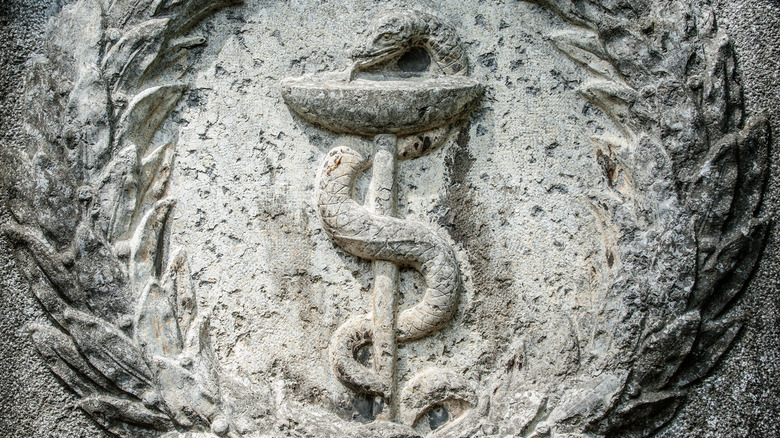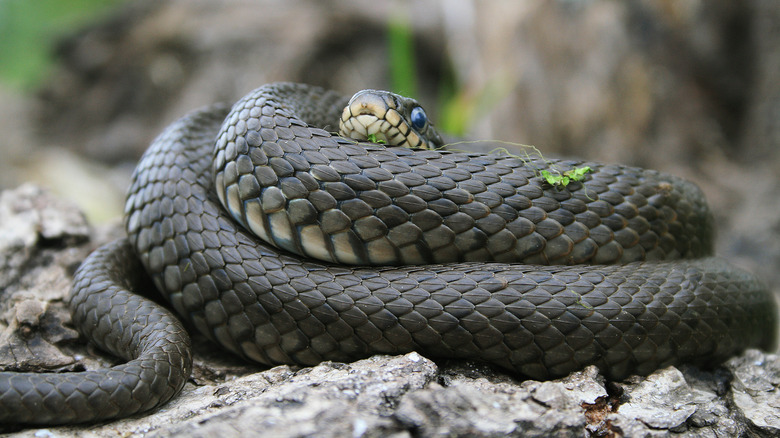How A 4,400-Year-Old Shaman's Snake Staff Rewrites Finnish History
In Numbers 21:4-9 in the Bible, as recounted on The Torah website, Moses crafts a bronze serpent — a "saraph" — and mounts it on a staff to cure those Israelites who've been bitten by poisonous snakes sent my God. Simply gaze at the imitation snake and voila: instant cure. This is an example of, as it's called in art and anthropology, "sympathetic magic," when a rendition of something allows the original's power to be co-opted (per Learn Religion). Such beliefs might have motivated antediluvian cave paintings of gazelles, mammoths, boars, and others, going back to at least 45,000 BCE (per New Scientist). By capturing something in form and shape, it can be better understood. And if it can be understood, it can be dominated, or possibly wielded.
Though King Hezekiah in 2 Kings 18:4 destroyed the bronze serpent, dubbed the "Nehushtan," the notion of a "healing snake" lived on. The Greek God of Medicine Asklepios (Aesculapius in Roman myth) was connected to snakes through a story about how he used a leaf to resurrect the ruler of Crete's son, Minos. The leaf was, essentially, gifted to him by a snake, per Doctor's Review. And now, the Staff of Aesculapius (a single snake wound around a staff) and its cousin, the Caduceus (the snake with two intertwined snakes), are symbols of medicine.
Recently, though, an actual, wooden snake staff was discovered in an area very far away from the Near East or the Mediterranean: Finland.
A single piece of mummified wood carved like a snake
In June, 2021, a wooden "snake staff" was discovered on an archaeological dig in the Finnish wetlands of Järvensuo in the southwest of the country, about one hour northeast of the coastal city of Turku. Turku, it should be said, was one of the first footholds of Christianity in Finland by way of the then-Kingdom of Sweden to the west, and home of one of the country's oldest cathedrals, the 14th-century Turku Cathedral, as the Turku Student Village Foundation explains.
The 53-centimeter-long staff (21 inches) dates back to around 2400 BCE, as Live Science reports. It's made of a single piece of wood and curved with a head that resembles either a grass snake, European adder, or viper (up for debate). Basically, it looks like a snake slithering on the ground. The area is full of peat — decaying plant matter low in nutrition and oxygen (per National Geographic) — which likely preserved the staff same as peat bogs have mummified whole "bog people" such as Tollund Man in Demark, as the Museum Silkeborg shows.
Per LiveScience, Archeologist Satu Koivisto said, "I have seen many extraordinary things in my work as a wetland archaeologist, but the discovery of this figurine made me utterly speechless and gave me the shivers." Sonja Hukantaival, postdoctoral researcher in Nordic Folkloristics at Åbo Akademi University in Finland, emphasized the find's religious importance, as vipers have strong shamanistic, pre-Christian significance in the area.
A clue from ancient times preserved among the history of numerous peoples
So what does this staff signify, really? First of all, banish all thoughts of "druids," if that was the first thing that words like "shaman" and "snake staff" evoked. Those guys were over in Gaul (modern-day Western Europe) and Briton (modern-day England and Wales, basically). Truth be told, we really don't know much about them, and most of what we know comes from biased accounts of Roman historians, as National Geographic explains.
Back to Finland: the "shaman snake staff" puts pre-Christian Finnish beliefs on a clearer timeline. Finland, as we know it, is a new country established only in 1917. It was always composed of a variety of peoples: Ingrian, Karelian, and more, outlined on Fenno-Ugria, themselves composed of smaller regional groups. In the end, they can be separated into Baltic-Finnic (aka "Finno-Ugric" from Eastern Europe) and Saami (indigenous people, often spelled Sámi). Baltic-Finnic peoples settled in southern Finland and became "Finns," and the Saami in northern Finland, i.e., Lapland, extending out to modern-day northern Norway and Sweden, per Fenno-Ugria. Also, as This is Finland explains, we've got lots of population circulation between Russia, Estonia, on top of numerous border re-drawings. Basically, there is no unified "Finnish" culture, Neolithic or otherwise, and ancient times were doubtlessly composed of a complex web of cultural intermingling.
Plus, Finland was subjugated by Sweden until 1863, and its native language suppressed, as Omniglot explains. Documents are scarce, and knowledge of the distant past is limited.
The symbol of a spiritual helper from the Neolithic era
To add to the mystery, the style of the staff doesn't match anything in our archaeological record, as the Cambridge University Press discusses. We also have no way of knowing if it was lost, discarded, or stored and forgotten. The closest comparisons in style come from a clay figurine 100km northwest of the dig site depicting a coiled snake. Within the surrounding region, snakes can also be found in artwork in Russia, Northern Europe, and more, much like in the Bible and ancient Greece.
So, is the staff a "Stone Age shaman's staff," as National Geographic puts it? We can only go as far back in the historical record as we know. As co-author of the find's study Antti Lahelma from the University of Helsinki said, the staff "brings to mind northern shamanism of the historical period, where snakes had a special role as spirit-helper animals of the shaman." Moreover, as Cambridge University Press says, "Snakes are loaded with symbolic meaning in both Finno-Ugric and Sámi cosmology, and shamans were believed to be able to transform into snakes." Additionally, the "Land of the Dead was believed to lie underwater," which is super interesting given the wetlands where the staff was found.
In the end, just like Moses' Nehushtan or the Staff of Aesculapius, it seems reasonable to assume that the wielder, like all shamans, was a healer and guide taking "sympathetic magic" lessons from our belly-bound animal brother.



